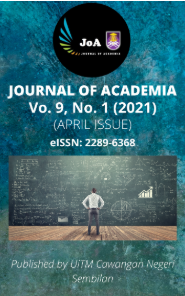BIOMASS ACTIVATED CARBON PROPERTIES THROUGH ACTIVATION METHOD FOR SUPERCAPACITOR – A MINI-REVIEW
Keywords:
Activated carbon, biomass, electrodes, supercapacitor, renewable energyAbstract
Recently, the development of activated carbon electrodes from agricultural waste biomass for application in carbon-based electrode of supercapacitor is increasing. The use of agricultural waste biomass as a precursor for the production of activated carbon become popular because it is economical, easily available and also beneficial in reducing waste disposal problem in agricultural industries. In this review, the biomass material for activated carbon using various activators is presented. The effects of activating methods which is physical and chemical activation on the properties of activated carbons are reviewed. Carbonaceous materials with high surface area, which is above 1000 m2g-1 and good porosity with total pore volume approximately 1.0 cm3g-1 promote fast ion-transport, making them an ideal choice to be used in supercapacitor. Previous study had shown that different types of activation method influence significantly on the properties of activated carbon produced. Producing a high porosity and high surface area of activated carbon are essentials to fabricate a high quality of supercapacitor. With proper treatment, it is found that many agriculture wastes have high potential and carry good properties as an electrode in supercapacitor.
References
Ahmed, S., Ahmed, A., & Rafat, M. (2018). Supercapacitor performance of activated carbon derived from rotten carrot in aqueous, organic and ionic liquid-based electrolytes. Journal of Saudi Chemistry Society, 22, 993–1002.
Aworn, A., Thiravetyan, P., & Nakbanpote, W. (2008). Preparation and characteristics of agricultural waste activated carbon by physical activation having micro-and mesopores. Journal of Analytic Application Pyrolysis, 82, 279–85.
Azam, T. M. D., Hameed, B.H., & Ahmad, A. L. (2009). Batch adsorption of phenol onto physiochemical-activated coconut shell. Journal of Hazardous Material, 161, 1522-29.
Bhat, Y., Yadav, N., & Hashmi, S. A. (2019). Pinecone-derived porous activated carbon for high performance all-solid- state electrical double layer capacitors fabricated with flexible gel polymer electrolytes. Electrochimica Acta, 304, 94–108.
Chafia, B., Medjram, M. S., Bertrand, O., & Bellat, J. P. (2008). Preparation and characterization of activated carbon from date stones by physical activation with steam. Journal of Analytic Application Pyrolysis, 82, 70-77.
Dhelipan, M., Arunchander, A., Sahu, A. K., & Kalpana, D. (2017). Activated carbon from orange peels as supercapacitor electrode and catalyst support for oxygen reduction reaction in proton exchange membrane fuel cell. Journal of Saudi Chemistry Society, 21, 487–494.
Farma, R., Deraman, M., Awitdrus, A., Talib, I. A., Taer, E., & Basri, N. H. (2013). Preparation of highly porous binderless activated carbon electrodes from fibres of oil palm empty fruit bunches for application in supercapacitors. Bioresource Technology, 132, 254–61.
Ghosh, S., Santhosh, R., Jeniffer, S., Raghavan, V., Jacob, G., Nanaji, K., Kollu, P., Jeong, S. K., & Grace, A. N. (2019). Natural biomass derived hard carbon and activated carbons as electrochemical supercapacitor electrodes. Scientific Reports, pp. 1–15.
Ismanto, A. E., Wang, S., Soetaredjo, F. E., & Ismadji, S. (2010). Preparation of capacitor’s electrode from cassava peel waste. Bioresource Technology, 101, 3534-40.
Khalil, H. P. S., Jawaid, M., Firoozian, P., & Rashid, U. (2013). Activated Carbon from Various Agricultural Wastes by Chemical Activation with KOH: Preparation and Characterization. Journal of Biobased Mat and Bioenergy, 7, 708-17.
Kumar, A., & Jena, H. M,. (2016). Preparation and characterization of high surface area activated carbon from Fox nut (Euryale ferox) shell by chemical activation with H3PO4. Results in Physics, 6, 651–658.
Liu, Q. S., Zheng, T., Wang, P., & Guo, L. (2010). Preparation and characterization of activated carbon from bamboo by microwave-induced phosphoric acid activation. Industrial Crops and Products, 31, 233–8.
Mensah-darkwa, K., Zequine, C., Kahol, P. K., & Gupta, R. K. (2019). Supercapacitor Energy Storage Device Using Biowastes: A Sustainable Approach to Green Energy. Sustainability, 11, 414.
Nabais, J. V., Carrott, P., Ribeiro Carrott, M. M., Luz, V., & Ortiz, A. L. (2008). Influence of preparation conditions in the textural and chemical properties of activated carbons from a novel biomass precursor: the coffee endocarp. Bioresource Technology, 99, 7224–31.
Pagketanang, T., Artnaseaw, A., & Wongwicha, P. (2015). Microporous Activated Carbon from KOH-Activation of Rubber Seed-Shells for Application in Capacitor Electrode. Energy Procedia, 79.
Saygili, H., & Güzel, F. (2016). High surface area mesoporous activated carbon from tomato processing solid waste by zinc chloride activation: Process optimization, characterization and dyes adsorption. Journal of Cleaner Production, 113, 995–1004.
Senthilkumar, S. T., & Selvan, R. K. (2013). The Biomass Derived Activated Carbon for Supercapacitor. AIP Conference Proceedings, 124.
Sivachidambaram, M., Vijaya, J. J., Kennedy, L. J., Jothiramalingam, R., Al-lohedan, H. A., Munusamy, M. A., Elanthamilan, E., & Merlin, J. (2017). Preparation and characterization of activated flower as an electrode material for supercapacitor applications. Journal of Chemistry, 41, 3939–3949.
Vunain, E. (2017). Synthesis and characterization of low-cost activated carbon prepared from Malawian baobab fruit shells by H3PO4 activation for removal of Cu (II) ions: equilibrium and kinetics studies. Applied Water Science, 7, 4301–19.
Xu, B., Chen, Y., Weib, G., Caoa, G., Zhanga, H., & Yang, Y. (2010). Activated carbon with high capacitance prepared by NaOH activation for supercapacitors. Journal of Material Chemistry and Physic, 124, 504-9.
Xie, Z., Guan, W., Ji, F., Song, Z., & Zhao, Y. (2014). Simultaneous calibration of the intrinsic and extrinsic parameters of structured-light sensors. Optics and lasers in Engineering, 58, 9-18.
Downloads
Published
Issue
Section
License
Copyright (c) 2021 Journal of Academia

This work is licensed under a Creative Commons Attribution-NonCommercial-NoDerivatives 4.0 International License.












